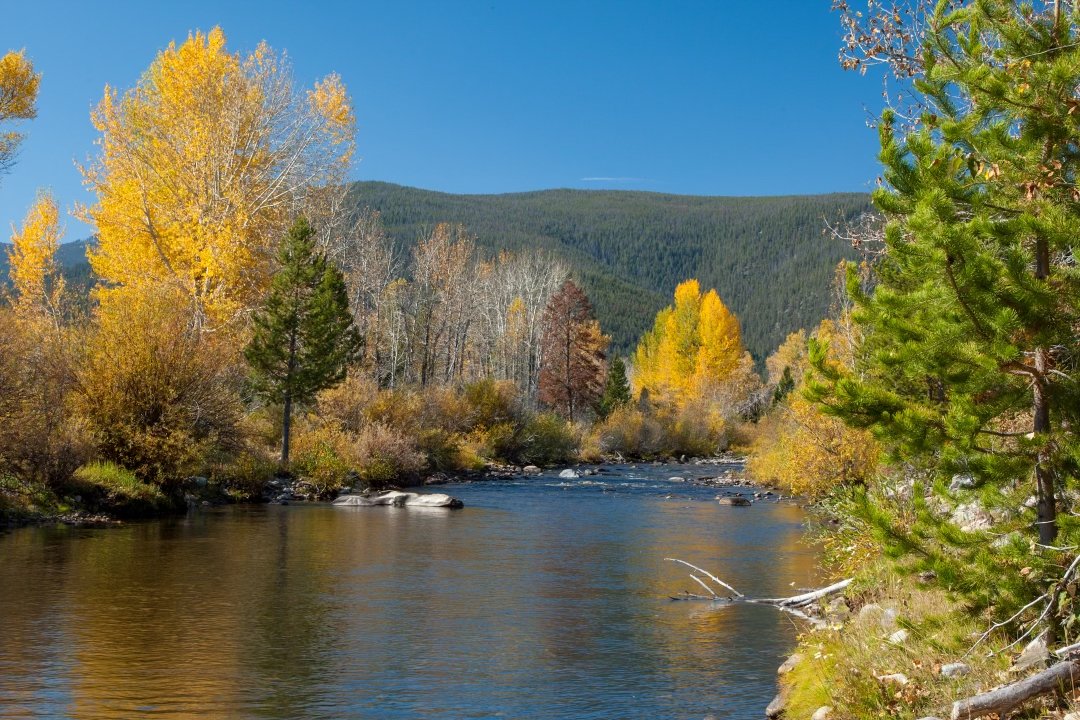Fall Fisheries News, Water Quality Monitoring Results, and River Closures
2023 Fishing Season Winding Down
Welcome, another fishing season is all but in the books for our beloved Jefferson Basin. After an uncertain start to the season, many of our partners and supporters still had some great fishing. And, perspective is important because any day on a river in the basin is almost guaranteed to be better than any day in the office. If you haven’t seen it, the Montana Fish and Wildlife Commissioners approved mandatory fishing closures on several river sections starting this month to help protect spawning brown trout and reduce pressure during the low-flow fall. It’s a smart move that SWT encouraged Fish and Wildlife Commissioners to implement.
Make no mistake, Southwest Montana is still a world-class fly fishing mecca that is the envy of anglers across the globe. But there is no denying the realities of a six-year declining wild trout population trend culminating in historically low numbers this season. This year’s low numbers were even more concerning considering it was a ‘good’ snow and water year by all accounts. Some timely rain also helped just when summer temperatures were peaking. In the near term, we are hopeful the measures to reduce angling pressure this Fall and a better water year without as many days of extreme heat will help wild trout populations next season.
Unfortunately, there is no silver bullet for low instream flows. To protect and maintain healthy wild trout populations we need to build resiliency throughout the system, meaning work needs to be done outside of the narrow scope of Fish, Wildlife, and Parks’ angler pressure study that is still not off the ground. It’s also imperative that other government agencies and partners engage in this effort, sharing data as it becomes available to help inform next steps. With only three real-time water and temperature gauges across the basin, the U.S. Geological Survey (USGS) and Department of Natural Resources (DNRC) should be working cooperatively to expand readily available water resource data. Additionally, if the Department of Environmental Quality (DEQ) prioritized implementing needed nutrient pollution controls, also known as total maximum daily loads (TMDLs), outlined over a decade ago, on the Big Hole River, we could better understand what could be done to reduce known pollution and improve water quality.
SWT will be pushing for these and many other science-based commonsense measures to protect wild trout now and for future generations. SWT’s science-lead, Dr. Flynn, has already been in the field collecting data, and shared his observations below. We are also planning for next season, building out our new advisory board that we are hoping to announce this month, share some important news updates, and provide more information on fishing closures below.
As always, thank you for defending wild trout, staying engaged, being a supporter, and please don’t hesitate to reach out to us at info@savewildtrout.org if you have any insights or questions. Rest assured that SWT is charging forward, working to find science-based solutions.
Science Update from Dr. Flynn
SWT performed baseline monitoring during late summer of 2023 to assess abiotic factors influencing the health of the Jefferson Basin fishery. Work included diurnal measurement of water temperature, dissolved oxygen (DO), hydrogen ion concentration (pH), specific conductance (SC), and turbidity, many of which are stressors and contributing factors to fungal infections in salmonids. Monitoring sites were selected to coincide with existing agency fish population sampling reaches, noting the spatial distribution of sites generally fits a Control-Impact (CI) design. Consequently, general inferences about water quality changes over space can be made, where relatively unaffected sites in the upper sections of a river are compared with sites in lower reaches that have been influenced to varying degrees by disturbance or management. Sites of interest were evaluated over an approximate 5-day critical period at key river mile (RM) on the Beaverhead, Ruby, Big Hole, and Jefferson rivers when seasonal low flows, high air temperatures, and warm water temperatures would be limiting to the fishery. Based on preliminary data, the following was observed:
All rivers showed longitudinal warming between the upper and lower sites, on the order of about 7°F for tailwater systems (Beaverhead and Ruby rivers) and roughly half that (2 to 3°F) for free-flowing rivers (Big Hole and Jefferson rivers). Maximum daytime water temperatures exceeded 68°F (SWT’s recommended cold-water fish threshold) at all sites except those that were immediately downstream of reservoirs, noting that all impoundments are bottom release facilities that result in cold water discharges lower than ambient air temperature.
In addition to longitudinal warming, concomitant increases in primary productivity were observed, with larger diurnal cycles in both DO and pH at downstream sites versus upstream sites. In one location, DO water quality excursions were close to impacting all life stages at night (i.e., <5 mg/L on successive days) whereas nighttime one-day minimum DO of 8 mg/L necessary to maintain 5.0 mg/L inter-gravel concentrations for early aquatic life stages was not achieved consistently in any river.
River-specific observations were as follows:
Beaverhead River – Monitoring data suggest that the Beaverhead River is productive with daytime DO concentrations approaching 140% of saturation at the Hennebury FAS (RM 69.9, upper) and >170% at Anderson Lane Bridge (RM 38.6, lower). Daytime pH was <8.7 S.U., indicating a well buffered system. A wastewater signature was observed in SC at the Anderson Bridge site, which is downstream of Dillon, MT.
Ruby River – The Ruby River showed less productive conditions, with daytime DO saturation <140% and pH <8.6 S.U. at both Vigilante FAS (RM 43.3) and Seyler Bridge (RM 2.0). There was an approximate 10% longitudinal increase in specific conductivity between the two monitoring sites and a large-scale increase in turbidity (>10x). The cause of the turbidity is unknown but is believed to be at least partially related to increases in streamflow.
Big Hole River – The Big Hole had substantially lower SC than any other river monitored (i.e., <250 mS/cm vs. >400 mS/cm) and was less productive than the Beaverhead or Ruby rivers, with diurnal DO <140% saturation. An act of vandalism (removal of the sonde from the Jerry Creek FAS, RM 61.4) precluded completing a robust evaluation of the data, however it was noted that the DO concentration at the Notch FAS (RM 17.8, lower) dropped below 5 mg/L on two consecutive nights on August 18th and August 19th, 2023, a threshold that can be impactful to adult fish.
Jefferson River – Sites on the Jefferson River were consistent with the aggregate response of the upstream monitoring locations. The upper Jefferson River at Hells Canyon FAS (RM 66.0) exhibited primary production comparable to other rivers (DO saturation >160%), which declined downstream to roughly 140% at Drouillard FAS (RM 7.6). The magnitude of pH at Hells Canyon FAS was the greatest of any river monitoring site with daytime highs near 9.0 S.U., declining downstream as buffering capacity of the watershed increased.
Based on 2023 observations, thermal, nutrient, and sediment related water-quality impacts are potentially occurring within the Jefferson Basin. The extent to which the fishery is impacted is not well understood, nor is the degree to which those impacts are controllable. Moreover, there is a need for further understanding of the spatial and temporal extent of early life stage impacts on fish and macroinvertebrates pertinent to water quality standards in DEQ-7, as well as the cumulative effect of chronic stressors, notably the combined effect of warm water temperature and cultural eutrophication.
Work in 2024 will largely be defined by a Jefferson Basin science panel, convened between SWT and agencies over the winter of 2023 to 2024. The panel, which will be overseen by a stakeholder advisory committee, will develop a collaborative and complimentary framework to develop hypotheses on possible impacts/stressors to salmonids in the basin, establish protocols to test those hypotheses, and implement monitoring campaigns to produce high quality credible data that accurately represent conditions in the watershed. Data and information from this effort will subsequently be used to answer scientific questions and guide resource management decisions. Anticipated work by SWT during 2024 will depend on the science panel recommendations but likely will include: measurement of chemical constituents that are acutely or chronically harmful to aquatic species (e.g., organics, toxics, metals, nutrients, pesticides, herbicides, etc.), characterization of physical habitat, trend analyses of daily streamflow and water temperature, and monitoring of abiotic factors to supplement agency-planned efforts. The efforts above are intended to be wholly complementary to the fish mortality, health, and histopathology studies planned by Montana Fish Wildlife & Parks in collaboration with Montana State University.
Reminder: October River Closures
As a friendly reminder, fishing closures went into effect on October 1st for sections of the Big Hole, Ruby, and Beaverhead rivers to protect trout during spawning season. These new closures were voted on by the Fish and Wildlife Commission in June to help reduce angling pressure on stressed trout populations.
Click here for more details on river sections currently closed to fishing.
Coming Soon: Save Wild Trout Advisory Board
SWT is assembling its advisory board to assist in the organization’s efforts to address the historically low wild trout populations in Southwest Montana rivers and develop science-based solutions to preserve wild trout for the benefit of all. The advisory board will work closely with the SWT coalition and science team to help guide scientific studies best suited for seeking answers to the crisis at hand. SWT is focused on bringing forward science-based policy solutions to get this river system and wild trout back on track, and the advisory board will help expand our net of expertise.
Stay tuned for updates.
SWT in the News
SWT has been making headlines in both local and national news. Two recent stories worth your time are the Montana PBS Impact Report and the Fly Fisherman magazine article from the Fall edition, “Disaster on the Big Hole” if you’re able to get your hands on a print copy.




